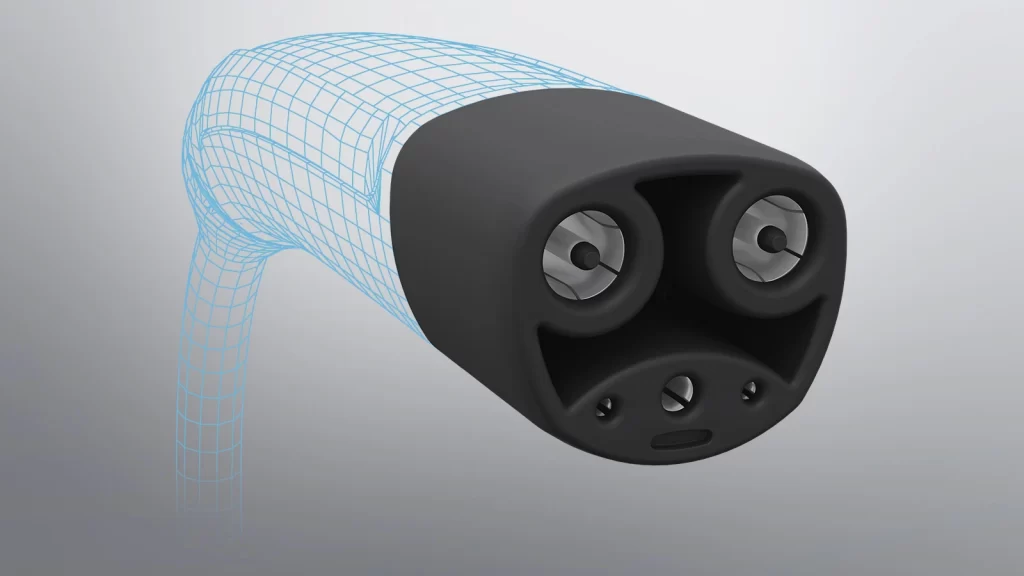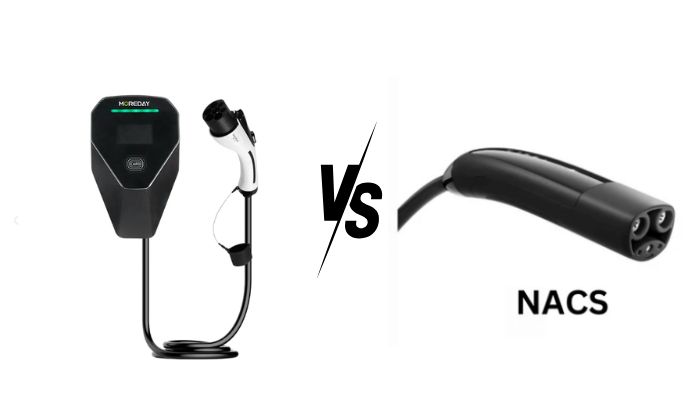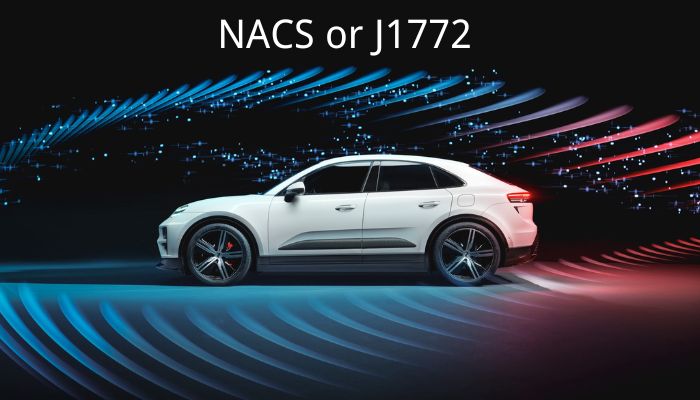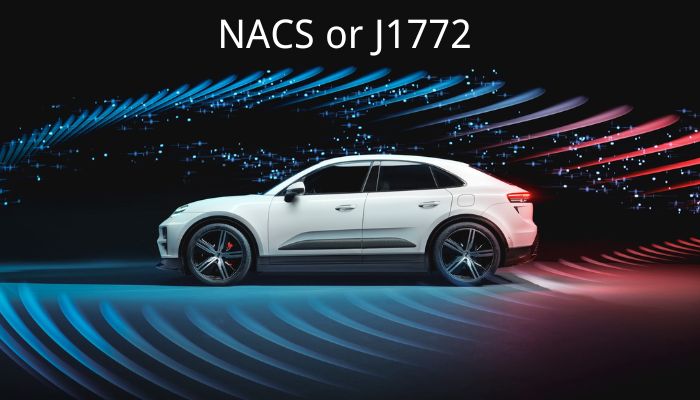With the rapid growth of the electric vehicle (EV) market, consumers are increasingly concerned about charging standards. Particularly for the upcoming luxury electric SUV, the Porsche Macan EV, one of the most important concerns for owners is which charging interface standard it will support: NACS (North American Charging Standard) or J1772 (Commonly Used Electric Vehicle Charging Standard in the U.S.).
This article will delve into the characteristics of these two charging standards and analyze the possible options for the Macan EV.
What is NACS?

NACS, or North American Charging Standard, is an electric vehicle charging standard introduced by Tesla and promoted in the North American market. It includes Tesla’s Supercharger network, a standard that supports DC fast charging, which offers the advantages of fast charging speeds and compatibility.
Tesla’s Superchargers already cover a large geographic area, making NACS highly utilized in the North American market. With NACS, Tesla owners can charge their vehicles to approximately 80% capacity in as little as 30 minutes.
The features of the NACS interface are as follows:
- High-speed charging: supports high-power DC fast charging, which is faster compared to traditional AC charging.
- Extensive network: Tesla’s Supercharger network covers a wide range of areas in the U.S. and beyond, providing users with a convenient charging experience.
- Future Potential: As more electric vehicle manufacturers choose to support NACS, this standard has the potential to become the mainstream charging standard in the North American market in the future.
What is J1772?
Connector-.webp)
J1772 is an electric vehicle charging standard developed by the Society of Automotive Engineers (SAE) and is widely used in North America and several regions around the world.
Unlike NACS, J1772 is primarily an AC charging standard, which is typically used for home charging pads or public charging facilities for most non-Tesla branded electric vehicles.J1772’s charging power is typically low, with a maximum of 19.2 kW, which makes for relatively slow charging speeds.
Features of the J1772 include:
- High ubiquity: almost all non-Tesla-branded electric vehicles support the J1772 standard, which makes J1772’s global reach very broad.
- AC charging: J1772 supports charging methods that are primarily AC charging, resulting in slower charging speeds and longer time to full charge than DC fast charging.
- Low cost: J1772 charging posts typically cost less to install and the infrastructure is more commonly available.
When comparing charging standards, it’s helpful to look at different options available, such as CCS. If you’re wondering how J1772 compares with other charging methods, you can read more about it in this detailed article: J1772 vs CCS: What’s the Difference?
Will Macan EV Have NACS or J1772?
So which charging standard will Porsche’s all-electric SUV, the Macan EV, choose? The Porsche Macan EV will feature the NACS (North American Charging Standard) connector. Porsche has announced that starting in 2025, its vehicles, including the Macan EV, will adopt the NACS port. This change aligns with the broader industry trend toward standardizing the NACS connector in North America, driven by Tesla’s open design licensing.
For now, the Macan EV will continue to use the CCS (Combined Charging System) connector, which is compatible with J1772 for AC charging. However, Porsche will provide adapters for NACS compatibility until the transition to the NACS port is complete. This ensures Macan EV owners can access Tesla Superchargers and other NACS-compatible charging networks.
What is the Difference Between NACS and J1772?

NACS (North American Charging Standard) and J1772 are two different charging standards, with significant differences in charging technology, speed, network coverage, and compatibility:
1. Charging Technology
NACS uses DC fast charging technology, which offers faster charging speeds and is ideal for long-distance travel and quick energy replenishment.
J1772, on the other hand, uses AC charging, which is slower and more suitable for daily home charging or extended parking periods.
2. Charging Speed
NACS supports high-power DC fast charging, with Tesla Superchargers delivering up to 250 kW or more, enabling rapid charging in a short time.
J1772 has a maximum power output of 19.2 kW, resulting in slower charging times, often requiring several hours to fully charge a vehicle.
3. Network Coverage
NACS leverages Tesla’s extensive Supercharger network, which is widely distributed across North America, making it highly convenient for long-distance travel.
J1772 charging infrastructure is more widespread, with nearly all public charging stations supporting the J1772 interface, especially in non-Tesla EV markets.
4. Compatibility
J1772 has strong compatibility, as almost all non-Tesla electric vehicles support this standard.
NACS has relatively lower compatibility, primarily limited to Tesla and a few other brands adopting the standard. However, with Tesla opening up the NACS standard, more automakers are beginning to adopt it.
Macan EV’s Charging Standard Choice

When selecting the charging standard for the Macan EV, Porsche must consider not only technical parameters but also market demand and the state of charging infrastructure. Here are some key factors:
1. Demand for Charging Speed
As a luxury electric SUV, the Macan EV’s consumers expect high charging speeds and convenience. Adopting the NACS standard would allow the Macan EV to access Tesla’s Supercharger network, offering fast charging capabilities and enhancing the user experience.
2. Market Positioning
If the Macan EV’s primary market is North America, NACS may be the more suitable choice due to the widespread availability of Tesla’s Supercharger network in the region. However, if the Macan EV is intended for global sales, the broad compatibility and prevalence of J1772 would be more advantageous.
3. Cost and Infrastructure
J1772 charging stations are generally less expensive to install, and the infrastructure is more mature. Supporting the J1772 interface ensures broader charging compatibility worldwide.
4. Future Trends
With more automakers (such as Ford, GM, and Rivian) announcing support for NACS, the adoption of this standard is rapidly increasing in North America. By choosing NACS, Porsche can not only meet current market demands but also align with industry trends.
Conclusion
The choice of charging standard for the Macan EV will significantly impact its performance in global markets. Both NACS and J1772 have their advantages:
- NACS: Ideal for the North American market, leveraging Tesla’s Supercharger network for fast charging and improved user experience.
- J1772: Offers high global compatibility and widespread availability, making it suitable for diverse markets.
Considering Porsche’s global market strategy and industry trends, the Macan EV is likely to adopt a dual-interface solution:
- In North America, the NACS interface will enable access to Tesla’s Supercharger network, meeting the demand for fast charging.
- In other global markets, the J1772 interface will ensure broad charging compatibility.
This flexible approach not only caters to the needs of consumers in different regions but also positions the Macan EV as a competitive player in the electric SUV market. As the demand for EVs grows, collaboration with EV charger manufacturers will become increasingly crucial in supporting the infrastructure needed to facilitate fast and reliable charging networks.
Click to learn: CCS1 vs. CCS2: What’s the difference?


